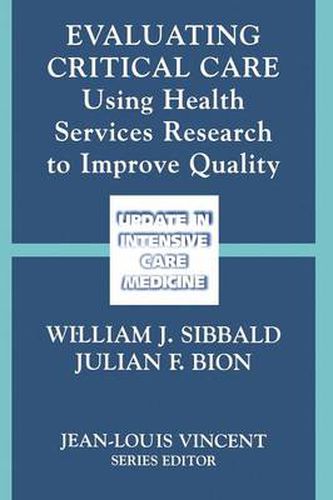Readings Newsletter
Become a Readings Member to make your shopping experience even easier.
Sign in or sign up for free!
You’re not far away from qualifying for FREE standard shipping within Australia
You’ve qualified for FREE standard shipping within Australia
The cart is loading…






This title is printed to order. This book may have been self-published. If so, we cannot guarantee the quality of the content. In the main most books will have gone through the editing process however some may not. We therefore suggest that you be aware of this before ordering this book. If in doubt check either the author or publisher’s details as we are unable to accept any returns unless they are faulty. Please contact us if you have any questions.
Measuring the quality of a complex service like critical care that combines the highest technology with the most intimate caring is a challenge. Recently, con sumers, clinicians, and payers have requested more formal assessments and comparisons of the quality and costs of medical care [2]. Donabedian [1] pro posed a framework for thinking about the quality of medical care that separates quality into three components: structure, process, and outcome. An instructive analogy for understanding this framework is to imagine a food critic evaluating the quality of a restaurant. The critic might comment on the decoration and lighting of the restaurant, how close the tables are to each other, the extent of the wine list and where the chef trained. These are all evaluations of the restaurant structure. In addition, the critic might comment on whether the service was courteous and timely - measures of process. Finally, the critic might comment on outcomes like customer satisfaction or food poisoning. Similarly, to a health care critic, structure is the physical and human resources used to deliver medi cal care. Processes are the actual treatments offered to patients. Finally, outcomes are what happens to patients, for example, mortality, quality of life, and satisfac tion with care (Table 1). There is a debate about which of these measurements is the most important measure of quality.
$9.00 standard shipping within Australia
FREE standard shipping within Australia for orders over $100.00
Express & International shipping calculated at checkout
Stock availability can be subject to change without notice. We recommend calling the shop or contacting our online team to check availability of low stock items. Please see our Shopping Online page for more details.
This title is printed to order. This book may have been self-published. If so, we cannot guarantee the quality of the content. In the main most books will have gone through the editing process however some may not. We therefore suggest that you be aware of this before ordering this book. If in doubt check either the author or publisher’s details as we are unable to accept any returns unless they are faulty. Please contact us if you have any questions.
Measuring the quality of a complex service like critical care that combines the highest technology with the most intimate caring is a challenge. Recently, con sumers, clinicians, and payers have requested more formal assessments and comparisons of the quality and costs of medical care [2]. Donabedian [1] pro posed a framework for thinking about the quality of medical care that separates quality into three components: structure, process, and outcome. An instructive analogy for understanding this framework is to imagine a food critic evaluating the quality of a restaurant. The critic might comment on the decoration and lighting of the restaurant, how close the tables are to each other, the extent of the wine list and where the chef trained. These are all evaluations of the restaurant structure. In addition, the critic might comment on whether the service was courteous and timely - measures of process. Finally, the critic might comment on outcomes like customer satisfaction or food poisoning. Similarly, to a health care critic, structure is the physical and human resources used to deliver medi cal care. Processes are the actual treatments offered to patients. Finally, outcomes are what happens to patients, for example, mortality, quality of life, and satisfac tion with care (Table 1). There is a debate about which of these measurements is the most important measure of quality.